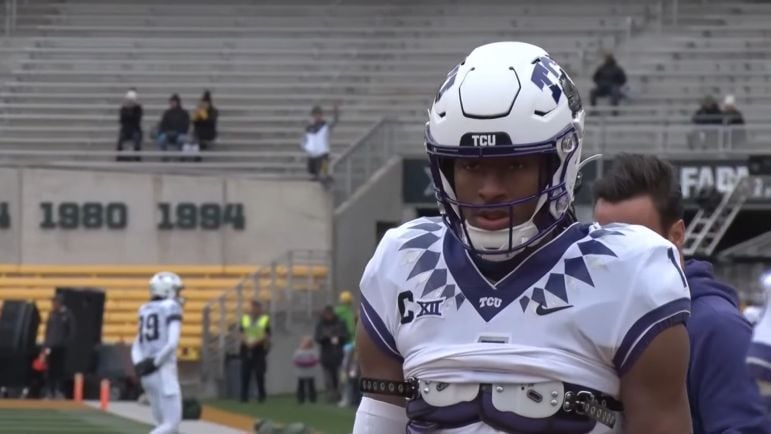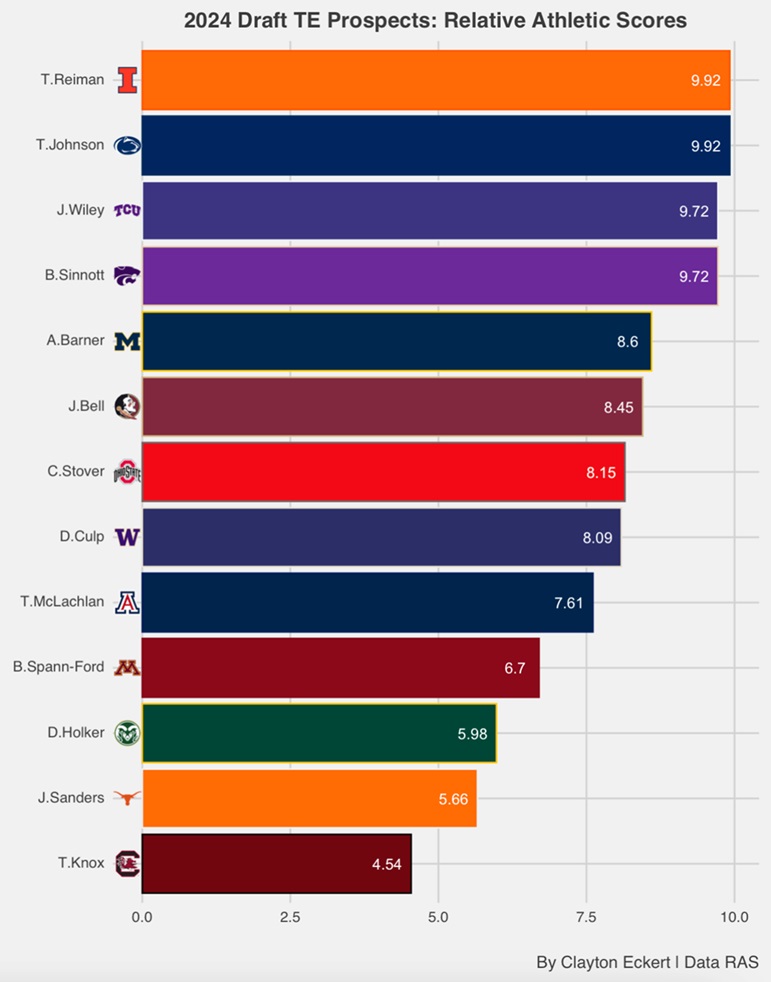Today, I wanted to visualize some great data from Kent Lee Platte’s Relative Athletic Scores (RAS) for tight ends (TE). Here is a link to Platte’s website in case you haven’t seen his work https://ras.football/.
To qualify for a RAS score, a player must have a total of six recorded metrics from any of the following: Height, Weight, Forty-yard dash, Twenty-yard split, Ten-yard split, Bench Press, Vertical Jump, Broad Jump, Short Shuttle, and 3-cone. The player is then graded on each in comparison to the positional database since 1987 to get more of a feel of their size, speed, explosion, agility, and total value, giving context to the raw numbers.
The goal of the series is to provide the RAS from Platte, and visualize it to get a simultaneous view of all the players at their position that participated at the combine. Here are the players that qualified for a RAS (NOTE: Positions are grouped from the scouting combine results tracker compiled by Dave Bryan and Alex Kozora):
Here, we see four TEs with a RAS above nine, compared to eight in my 2023 TE RAS article. Currently, two players are tied for the top spot in this year’s draft. Tip Reiman of Illinois (9.92 RAS) has great size, speed, and agility, with good explosion. 32 7/8” arms and 10 1/2” hands. Theo Johnson of Penn State (9.92 RAS) is the other, with elite speed and explosion, and great size and agility. 33” arms and 10 1/4” hands.
TCU’s Jared Wiley (9.72 RAS) has elite speed, great explosion, good size, but didn’t qualify in agility (no shuttle, 7.19 three cone). 33 1/4” arms and 9 1/2” hands.
Ben Sinnott of Kansas State (9.72 RAS) has elite explosion and agility, great speed, and okay size. 32 3/8” arms and 9 1/2” hands.
Four players have a RAS in the eight range. Michigan’s AJ Barner (8.6 RAS) has good size, explosion, and agility, with okay speed. Nice 33 3/8” arms. Smaller 9” hands.
Jaheim Bell of Florida State (8.45 RAS) has elite speed, great explosion, but very poor size, and no agility testing. 33” arms and 10” hands.
Ohio State’s Cade Stover (8.15 RAS) has great speed, good explosion, but poor size and didn’t qualify in agility (4.45 shuttle, no three-cone). 32 3/4” arms and 9 3/4” hands.
Devin Culp of Washington (8.09 RAS) has elite speed, good explosion and agility, but very poor size. 32 7/8” arms and 9 1/4” hands.
One player in the seven tier is Arizona’s Tanner McLachlan (7.61 RAS). He has great speed, okay size, good explosion, but poor agility. Shorter 31 5/8” arms. 9 3/8” hands.
Just one in the six tier as well, Brevyn Spann-Ford of Minnesota (6.7 RAS). He has elite size, good speed, okay explosion, but poor agility. Nice 33 3/8” arms and 10 1/4” hands.
Two players have a five-plus RAS. Colorado State’s Dallin Holker (5.98 RAS) has elite agility, good explosion, okay speed, but poor size. Good length (33 5/8” arms), 10 1/4” hands.
Ja’Tavion Sanders of Texas (5.66 RAS) has great speed, but poor size, explosion, and didn’t qualify in agility (4.32 shuttle, no three-cone). 32 5/8” arms and 10 1/8” hands.
The lowest TE RAS of 4.54 is South Carolina’s Trey Knox (4.54 RAS) He has good explosion, with okay speed and agility, but very poor size. Great 34 1/4” arms. 9 3/8” hands.
There are more prominent needs for Pittsburgh, likely steering them to other positions in the 2024 draft.
For those that like the numbers, it’s unfortunate a few players didn’t test fully, and it will be interesting to monitor the pro days and continue to see how the men stack up in the coming weeks when Platte updates the site with the unofficial numbers.
What are your thoughts on the data? Thanks for reading, and let me know your thoughts in the comments!









